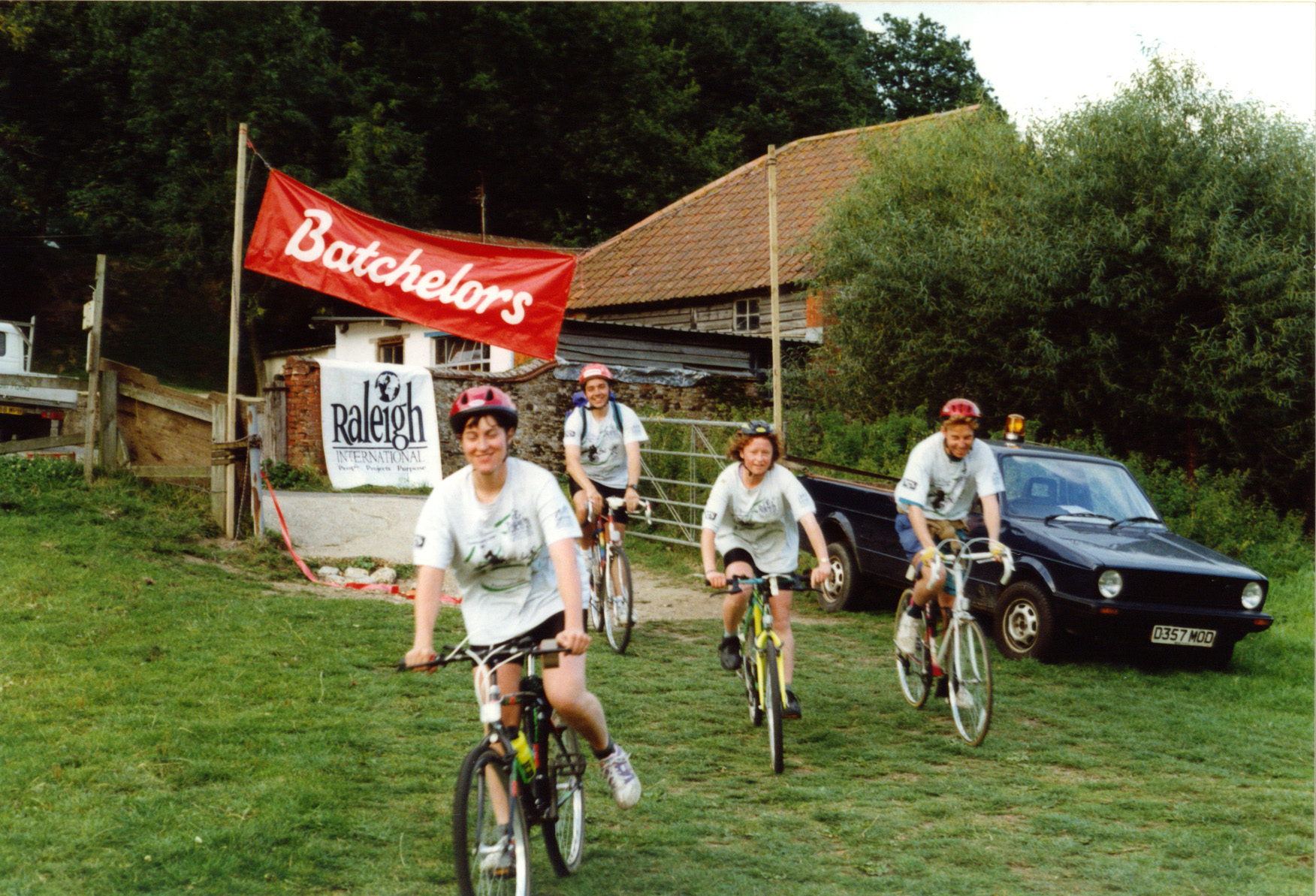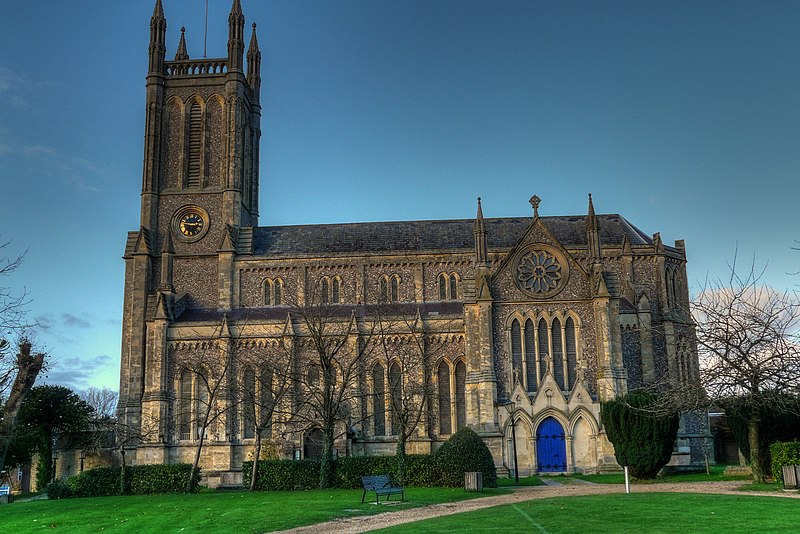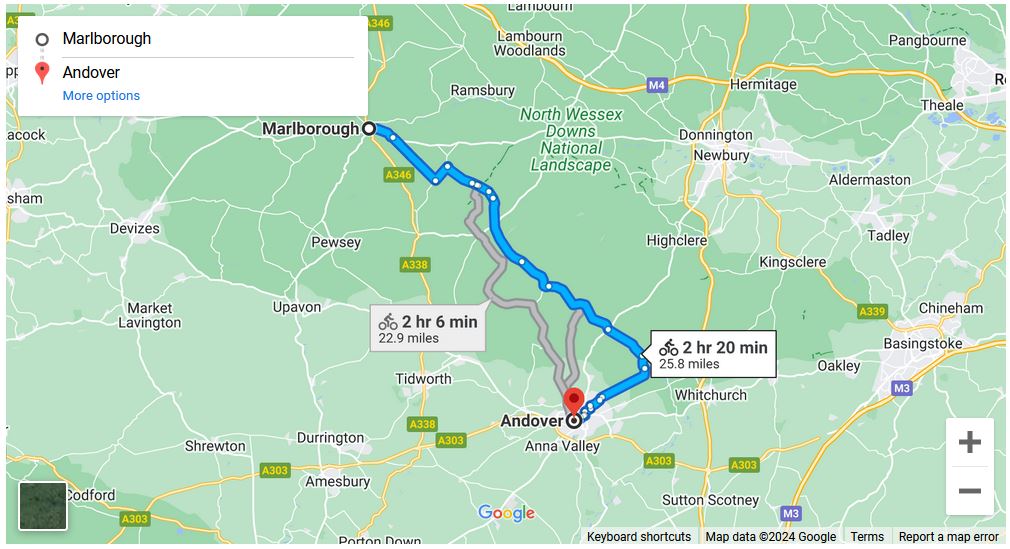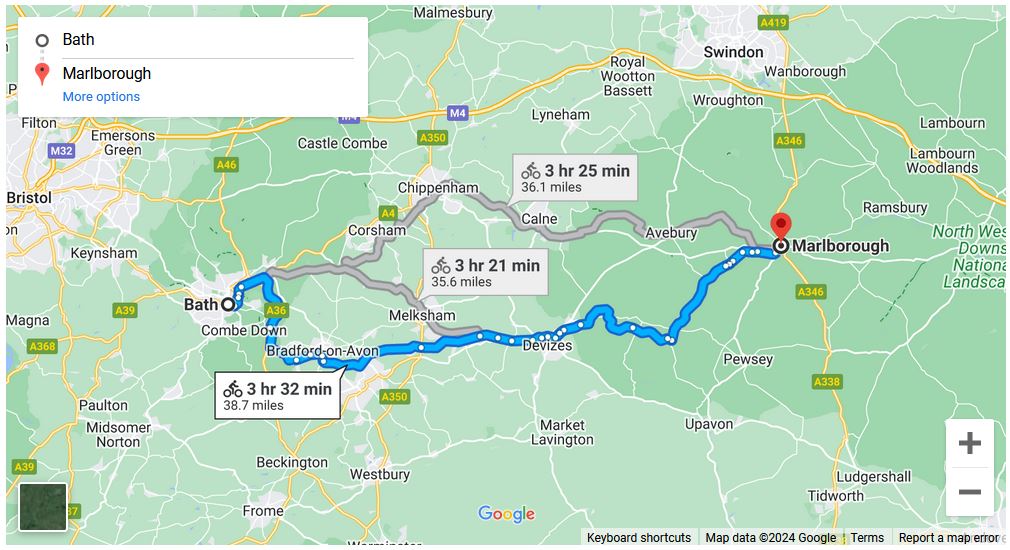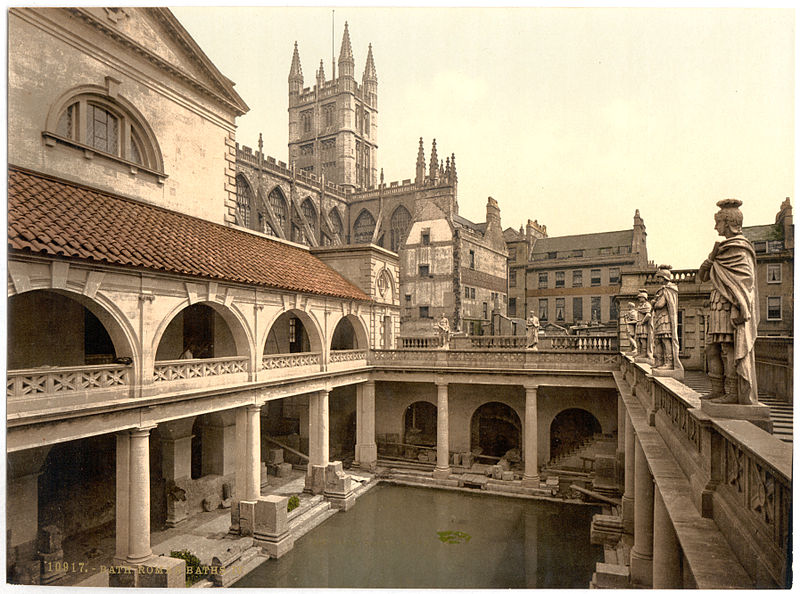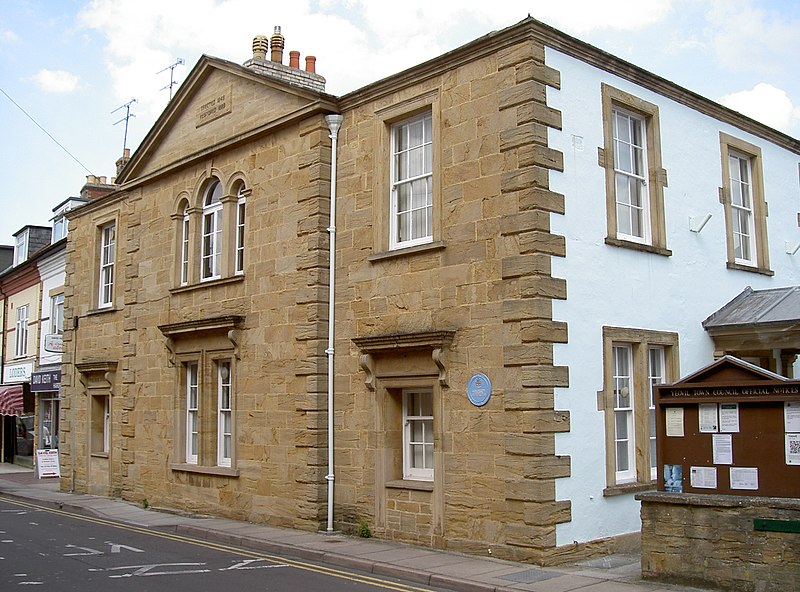End of the Bike Ride.
August 1993
Farnham, a historic market town nestled in the Surrey countryside, is a charming and picturesque destination with a rich history, a vibrant cultural scene, and a thriving community. Located about 40 miles southwest of London, Farnham combines the allure of a market town with the tranquility of its rural surroundings.
The town’s history can be traced back to the Roman period, and evidence of its medieval past is evident in structures like Farnham Castle, which dates back to the 12th century. The castle, perched on a hill overlooking the town, is a blend of Norman and Tudor architecture and has played a role in various historical events. Today, it serves as a venue for events, including weddings and conferences, and offers guided tours to visitors interested in its historical significance.
Farnham’s town center is characterized by narrow streets lined with Georgian and Tudor-style buildings, creating an atmosphere that seamlessly blends the old with the new. The market town tradition is alive and well in Farnham, with a regular market held on the cobbled streets offering fresh produce, artisanal goods, and a variety of local wares.
In addition to its historical sites, Farnham boasts beautiful green spaces, including Farnham Park. This expansive park offers walking trails, a playground, and stunning views of the surrounding countryside. The River Wey, which runs through the town, adds to the natural beauty and provides opportunities for riverside strolls.
Farnham Maltings, a cultural venue located in a former malting building, is a focal point for the arts in the town. It hosts a diverse range of events, including live performances, art exhibitions, and workshops. The Maltings also houses artists’ studios and a craft market, contributing to Farnham’s reputation as a hub for creativity and artistic expression.
The town’s commitment to the arts extends to the annual Farnham Festival of Crafts, celebrating craftsmanship and creativity. This event attracts artisans and visitors alike, showcasing the best of contemporary craft and design.
Farnham is known for its educational institutions, including the University for the Creative Arts (UCA), which has a campus in the town. UCA Farnham has played a significant role in fostering artistic talent and contributing to the town’s cultural vibrancy.
Local shops, boutiques, and cafes line the streets of Farnham, offering a diverse shopping experience. The town’s dining scene is equally varied, with a range of eateries serving everything from traditional British fare to international cuisine. Pubs and inns provide a cozy and welcoming atmosphere for residents and visitors alike.
Transport links connect Farnham to London and other nearby towns, making it accessible for both commuters and tourists. The town’s proximity to the Surrey Hills Area of Outstanding Natural Beauty adds to its appeal, offering opportunities for outdoor activities and exploration.
In summary, Farnham combines history, culture, and natural beauty to create a town that captivates both residents and visitors. Its market town charm, artistic spirit, and community-oriented atmosphere make Farnham a delightful destination in the heart of Surrey.
Cycling from Andover to Farnham embarks on a journey through the picturesque landscapes of Hampshire, showcasing the quintessential English countryside. This approximately 35-mile route takes riders on a scenic adventure, featuring charming villages, undulating hills, and the timeless beauty of southern England.
Commencing in Andover, a market town with a rich history dating back to the Saxon era, cyclists may start by navigating through the town’s streets. Andover’s mix of historical landmarks, modern amenities, and green spaces provides a dynamic backdrop as riders embark on their journey eastward.
As cyclists leave Andover behind, the route takes them through the rolling hills and verdant countryside of Hampshire. The undulating terrain offers a pleasing mix of gentle climbs and descents, providing riders with panoramic views of the surrounding landscape. The road winds through quiet lanes, offering a tranquil escape from the urban environment.
Cycling through the Hampshire Downs, riders may encounter charming villages that dot the route. Each village, with its thatched cottages and historic architecture, adds to the rural charm of the journey. The villages also provide opportunities for cyclists to take a break, perhaps enjoying refreshments at a local tearoom or exploring the local attractions.
Approaching Whitchurch, a market town nestled in the Test Valley, cyclists may find themselves captivated by its historic streets and timber-framed buildings. The River Test, meandering through the town, adds to the scenic allure. Whitchurch’s welcoming atmosphere invites riders to explore its market square and perhaps learn about the town’s heritage at the Silk Mill.
Continuing southeast, the route leads cyclists through the Hampshire countryside, passing through open fields, woodlands, and crossing small streams. The changing scenery provides a serene backdrop for the journey, with the occasional glimpse of historic landmarks in the distance.
The road may lead cyclists through Odiham, a historic market town with a medieval charm. Odiham Castle, a ruined fortress dating back to the 13th century, stands as a testament to the town’s historical significance. Cyclists may choose to explore the town’s streets, visit local landmarks, or simply enjoy the peaceful ambiance of Odiham.
The journey progresses eastward into Surrey as cyclists approach Farnham. The landscape may shift as riders enter the outskirts of the market town, known for its Georgian architecture and cultural attractions. Farnham Castle, with its medieval origins, stands as a prominent landmark overlooking the town.
Arriving in Farnham, cyclists may find themselves in a town that seamlessly blends history with contemporary vibrancy. The town center, featuring the bustling Castle Street and the picturesque Gostrey Meadow, offers a welcoming conclusion to the cycling adventure. Cyclists can explore Farnham’s historic sites, visit local shops, or relax in one of the town’s parks.
Cycling from Andover to Farnham is a journey through the changing landscapes of Hampshire and Surrey. Each pedal stroke unveils the natural beauty and cultural richness of southern England, from the market town charm of Andover to the historic landmarks along the route and the welcoming streets of Farnham. So, saddle up and pedal through the changing scenes, where the road weaves through countryside, charming villages, and the timeless allure of Hampshire and Surrey.
Andover, a historic market town in Hampshire, England, has a rich heritage, a bustling town center, and a mix of cultural and recreational amenities. Situated on the River Anton, Andover has evolved from its agricultural and milling roots into a diverse community with a range of offerings for both residents and visitors.
One of Andover’s notable historical landmarks is the Grade I-listed St. Mary’s Church, a medieval church with a distinctive spire that dominates the town’s skyline. The church’s architecture reflects various periods, including Norman and Gothic styles, showcasing the town’s long history.
Andover has roots dating back to Saxon times, and its name is believed to originate from “Andovere,” meaning “on the bank of the Anton.” The town played a role in the wool trade during the medieval period and later became known for its thriving market.
The Town Mills, located on the River Anton, are a reminder of Andover’s industrial past. The mills have been repurposed and now house residential and commercial spaces, blending history with modern usage. The River Anton itself adds a picturesque element to the town, with walking paths along its banks providing a peaceful escape.
Andover’s town center is a vibrant hub, featuring a mix of traditional market stalls, high street shops, and independent retailers. The Chantry Centre, a shopping mall, adds to the retail offerings, providing a diverse shopping experience for residents and visitors alike.
For those interested in the arts, The Lights, an arts and entertainment venue in Andover, hosts a variety of performances, including live music, theater, and comedy. The venue also houses an art gallery and a cinema, contributing to the town’s cultural scene.
Andover is surrounded by scenic countryside, and the town serves as a gateway to the North Wessex Downs Area of Outstanding Natural Beauty. The surrounding landscape offers opportunities for outdoor activities, including hiking and exploring the picturesque villages and rural landscapes.
The Hawk Conservancy Trust, located near Andover, is a popular attraction for nature enthusiasts. This conservation center focuses on the welfare and conservation of birds of prey, offering educational programs and live demonstrations showcasing these magnificent birds.
Andover’s community spirit is evident in its events and festivals. The Andover Carnival, held annually, brings the community together for a day of festivities, parades, and entertainment. The Christmas Lights Switch-On is another highlight, creating a festive atmosphere in the town center.
Transport links connect Andover to London and other nearby towns, making it accessible for commuters. The town’s railway station provides direct routes to major cities, including London and Southampton.
In summary, Andover is a town that seamlessly blends its historical charm with modern amenities. Its diverse offerings, from cultural venues and markets to outdoor activities and community events, make it an appealing destination for residents and visitors seeking a mix of heritage and contemporary experiences.
Cycling from Marlborough to Andover leads riders through the picturesque landscapes of Wiltshire and Hampshire, unveiling a journey that combines rural charm, historic sites, and the natural beauty of the English countryside. This approximately 20-mile route takes cyclists on a delightful adventure, connecting two market towns with rich histories.
The cycling journey commences in Marlborough, a town steeped in history and known for its wide High Street, medieval architecture, and proximity to ancient sites such as Avebury Stone Circle. Leaving Marlborough, riders may traverse the town’s historic streets, enjoying the charm of its market square and the view of Marlborough College Chapel.
As cyclists venture eastward, the route unfolds through the rolling hills of Wiltshire. The undulating terrain provides a mix of gentle climbs and descents, allowing riders to appreciate the scenic beauty of the surrounding countryside. The Wiltshire Downs offer expansive views, with open fields, hedgerows, and occasional woodlands contributing to the quintessential English rural experience.
The route may lead cyclists through smaller villages, each with its own character and charm. These picturesque settlements, characterized by thatched cottages and historic churches, add to the timeless ambiance of the journey. Taking a moment to explore these villages provides a glimpse into the rural life of Wiltshire.
Approaching the town of Ludgershall, cyclists may find themselves immersed in its medieval history. Ludgershall Castle, a former royal residence, stands as a testament to the town’s past. The castle ruins and the nearby Ludgershall Church offer a fascinating stop for riders interested in exploring historical landmarks.
Leaving Ludgershall, the route continues southeast towards Andover. The road meanders through the Wiltshire and Hampshire border, with the landscape gradually changing as cyclists enter Hampshire. The ride takes on a more pastoral character, with rolling hills and quaint farmlands contributing to the visual appeal.
As cyclists approach Andover, they may find themselves cycling through the town’s outskirts, with the River Anton meandering nearby. Andover, a market town with a history dating back to the Saxon era, offers a blend of modern amenities and historical charm. The High Street, lined with shops and cafes, invites riders to explore the town center.
Andover also features noteworthy landmarks such as St. Mary’s Church, known for its medieval architecture, and the Andover Guildhall. The town’s mix of historical sites and contemporary facilities makes it a rewarding destination at the conclusion of the cycling journey.
Cycling from Marlborough to Andover is a blend of rural tranquility and historical exploration. The route takes riders through the changing landscapes of Wiltshire and Hampshire, offering a glimpse into the region’s rich heritage and natural beauty. Each pedal stroke unfolds a new chapter in this cycling adventure, from the market town elegance of Marlborough to the historical allure of Ludgershall and the welcoming streets of Andover. So, saddle up and pedal through the changing scenes, where the road weaves through countryside, historic landmarks, and the timeless charm of southwestern England.
Marlborough, a historic market town in Wiltshire, England, is renowned for its picturesque setting, rich history, and vibrant cultural scene. Nestled in the heart of the North Wessex Downs Area of Outstanding Natural Beauty, Marlborough offers a charming blend of historic architecture, independent shops, and a lively community spirit.
The town’s name is derived from “Maerla” and “Berga,” Old English words meaning “marten” and “hill,” respectively. The town has a history dating back to the prehistoric era, with nearby sites such as Avebury and Silbury Hill showcasing ancient monuments and earthworks.
Marlborough College, a prestigious public school founded in 1843, adds an academic and cultural dimension to the town. The college’s campus, with its historic buildings and expansive grounds, contributes to the town’s character. The annual Marlborough College Summer School, offering a variety of courses and activities, attracts participants from around the world.
The High Street in Marlborough is a focal point, featuring a wide, elegant avenue lined with Georgian and Victorian buildings. The town’s market tradition thrives, with regular markets held in the High Street providing fresh produce, artisanal goods, and a vibrant atmosphere. The Merchant’s House, a 17th-century silk merchant’s home, is now a museum showcasing period-appropriate furnishings and offering insights into Marlborough’s history.
One of Marlborough’s most iconic landmarks is Marlborough Town Hall, an elegant building with a clock tower that dominates the skyline. The town hall hosts various events and functions and is an important civic and cultural center.
The Kennet and Avon Canal, which passes through the town, adds a scenic element to Marlborough. The towpath along the canal provides a pleasant route for walking or cycling, with opportunities to enjoy the tranquil waterside setting.
The town is surrounded by beautiful countryside, making it a gateway for exploring the North Wessex Downs. Nearby landmarks such as Avebury, with its stone circle, and West Woods, known for its bluebell displays in spring, offer opportunities for outdoor activities and cultural exploration.
Marlborough is also known for its annual Jazz Festival, attracting musicians and enthusiasts from near and far. The festival showcases a variety of jazz genres and adds a lively and musical element to the town’s cultural calendar.
The White Horse Bookshop, an independent bookstore in Marlborough, contributes to the town’s cultural vitality. Established in 1943, it offers a diverse selection of books and hosts author events, providing a haven for book lovers.
With a mix of pubs, cafes, and restaurants, Marlborough’s dining scene reflects its varied offerings. The town’s eateries range from traditional English pubs to fine dining establishments, providing a culinary experience that caters to diverse tastes.
Marlborough’s accessibility by road and its proximity to larger towns such as Swindon and Salisbury make it an appealing destination for both residents and visitors. The town’s combination of history, culture, and natural beauty ensures that it remains a charming and inviting place to explore in the heart of Wiltshire.
Cycling from Bath to Marlborough takes riders through a captivating journey that combines the charm of historic Bath with the scenic beauty of the Wiltshire countryside. This approximately 35-mile route leads cyclists through picturesque landscapes, charming villages, and the rolling hills of southwestern England.
The adventure commences in Bath, a UNESCO World Heritage city known for its elegant Georgian architecture and Roman Baths. Starting from Bath’s city center, cyclists may pedal through cobbled streets, passing landmarks such as Bath Abbey and the Royal Crescent. Bath’s vibrant atmosphere and cultural richness set the stage for a cycling journey that unfolds through the timeless landscapes of Wiltshire.
Leaving Bath behind, the route may take cyclists through suburban neighborhoods and the surrounding countryside. The road meanders through the undulating hills, offering panoramic views of the Avon Valley. As cyclists pedal through this rural stretch, the tranquility of the countryside gradually replaces the urban backdrop, creating a peaceful and immersive cycling experience.
En route to Marlborough, cyclists may encounter charming villages that dot the landscape. The quaint cottages and historic architecture add to the rural charm, creating a quintessentially English scene. Villages like Lacock, with its medieval streets and picturesque setting, may invite cyclists to take a break and explore the local attractions.
Continuing northeast, the route leads riders through the scenic landscapes of Wiltshire. The rolling hills provide a mix of gentle ascents and descents, creating an engaging and rewarding cycling experience. The Wiltshire countryside, with its open fields, hedgerows, and occasional woodlands, offers a serene backdrop for the journey.
Approaching Marlborough, cyclists may find themselves cycling through the historic market town situated on the River Kennet. Marlborough is known for its wide High Street, lined with independent shops and cafes, as well as the medieval Marlborough College. The town’s iconic landmark, Marlborough College Chapel, adds a touch of architectural elegance to the town’s skyline.
Marlborough also boasts the ancient mound of Silbury Hill and the Avebury Stone Circle in close proximity, offering cyclists the option to explore the region’s rich historical and archaeological sites.
The journey from Bath to Marlborough encapsulates the essence of rural England, with its picturesque landscapes and historic towns. Each pedal stroke reveals a new facet of the region’s natural beauty and cultural heritage. Whether cycling through the charming streets of Bath, the tranquil countryside of Wiltshire, or the historic market town of Marlborough, riders are immersed in the timeless allure of southwestern England.
Cycling from Bath to Marlborough is not just a physical journey; it’s a passage through the layers of history, culture, and natural splendor that define this part of England. So, saddle up and pedal through the changing scenes, where the road weaves through urban elegance, rural tranquility, and the timeless charm of Bath and Marlborough.
Bath, a UNESCO World Heritage city in Somerset, England, is renowned for its rich history, stunning Georgian architecture, and natural hot springs. Nestled in the picturesque Avon Valley, Bath has been a destination of cultural and historical significance for centuries.
The city’s name is derived from the Roman-built baths and temples that were established here around AD 60. The Roman Baths, a well-preserved ancient bathing and socializing complex, stands as a testament to the city’s Roman origins. Visitors can explore the various chambers, the Great Bath, and the sacred spring, gaining insight into the Romans’ sophisticated engineering and bathing practices.
Bath Abbey, with its striking Gothic architecture, is another iconic landmark. Originally founded in the 7th century, the present-day abbey dates back to the 12th century. Its stunning fan vaulting, stained glass windows, and historic monuments make it a must-visit destination for history and architecture enthusiasts.
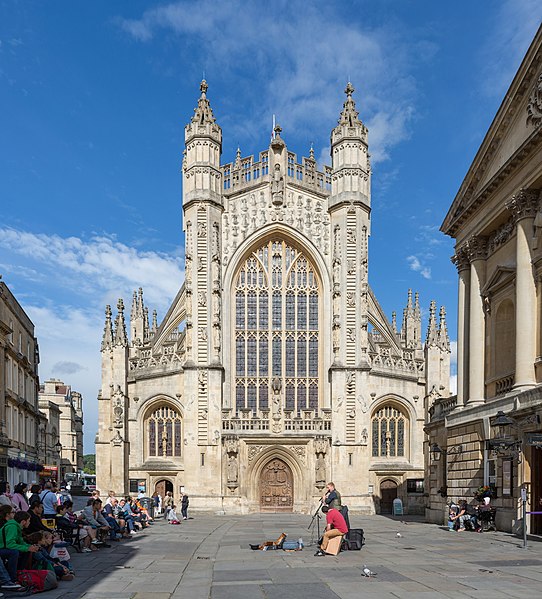
The Royal Crescent and the Circus are two of Bath’s most famous architectural ensembles. The Royal Crescent, a semicircular row of 30 terraced houses, exemplifies Georgian elegance and is one of the most iconic landmarks in the city. The Circus, a circular space surrounded by Georgian townhouses, showcases the work of architect John Wood the Elder.

Bath’s Pulteney Bridge is a picturesque crossing over the River Avon, lined with shops and cafes. Inspired by the Ponte Vecchio in Florence, Italy, Pulteney Bridge is one of only four bridges in the world to have shops across its full span on both sides.
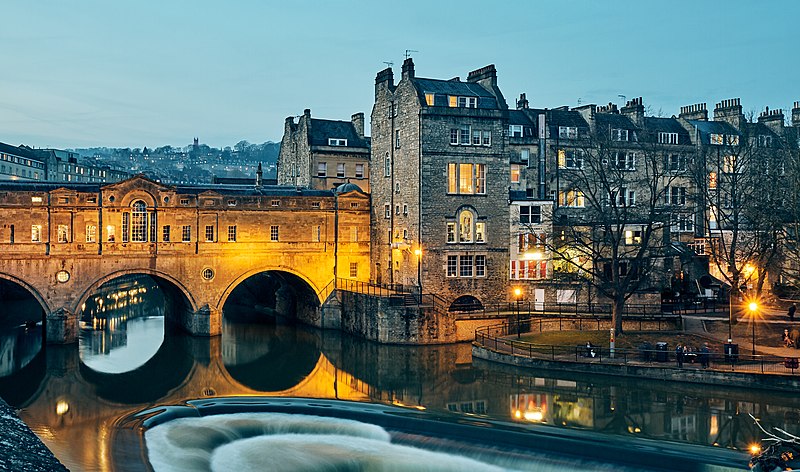
The city’s elegant streets are lined with Georgian townhouses and neoclassical architecture, creating a harmonious and visually appealing urban landscape. The Assembly Rooms, where high society gathered for social events in the 18th century, and the Pump Room, a grand venue for taking the healing waters, are additional architectural gems.
Bath’s hot springs have been a draw for centuries, and the Thermae Bath Spa allows visitors to experience the natural thermal waters in a contemporary setting. The rooftop pool offers panoramic views of the city, creating a modern complement to the historic bathing traditions.
Bath’s cultural scene is vibrant, with numerous museums and galleries. The Victoria Art Gallery, the Holburne Museum, and the Fashion Museum showcase a rich array of artistic and historical exhibits.
Bath’s literary heritage is celebrated through its association with famed author Jane Austen. The Jane Austen Centre provides insights into her life and works, and visitors can explore locations in the city that inspired her novels.
The city hosts various festivals and events throughout the year, including the Bath Festival, which features a mix of music, literature, and cultural activities. The Bath Christmas Market is also a popular seasonal attraction, transforming the city into a festive wonderland.
Bath’s culinary scene reflects its diverse offerings, with a range of eateries, from traditional tea rooms to Michelin-starred restaurants. The city’s emphasis on locally sourced and artisanal products adds to the culinary experience.
In conclusion, Bath is a city that seamlessly combines its Roman and Georgian heritage with modern amenities and cultural offerings. Its architectural splendor, thermal springs, and cultural richness make it a captivating destination for history lovers, art enthusiasts, and those seeking a sophisticated and relaxing escape in the heart of England.
Cycling from Bristol to Bath offers a delightful journey through the heart of the West Country, exploring the cultural and historical richness of southwestern England. This approximately 12-mile route takes cyclists along a scenic path, connecting two iconic cities known for their architectural splendor and vibrant atmospheres.
The adventure begins in Bristol, a city celebrated for its maritime history, eclectic street art, and vibrant cultural scene. Starting from the harborside area, cyclists may find themselves riding along the waterfront, passing landmarks such as the SS Great Britain, the M Shed museum, and the vibrant Bristol Aquarium.
As cyclists move away from the harbor, the route may lead through the city center, offering glimpses of Bristol’s historic architecture, including the Bristol Cathedral and the Bristol City Hall. The city’s lively streets and bustling markets contribute to the energetic ambiance, making the initial part of the journey a vibrant introduction to Bristol’s diverse character.
Heading eastward, the route takes cyclists along the Bristol to Bath Railway Path, a dedicated cycle path that follows the path of the former Midland Railway. This traffic-free route provides a pleasant and safe passage through the countryside, away from the hustle and bustle of city streets.
The path meanders through green corridors, passing through suburban neighborhoods and verdant landscapes. Cyclists may enjoy the tranquility of the path, surrounded by trees, shrubs, and the occasional glimpse of open fields. This part of the journey offers a relaxing escape from the urban environment and sets the stage for the picturesque countryside to come.
As cyclists approach the town of Saltford, situated approximately halfway between Bristol and Bath, they may find the opportunity to take a break and explore the local surroundings. Saltford, with its charming village atmosphere and the picturesque River Avon, provides a pleasant stop amid the journey. Cyclists can enjoy a snack at a local cafe, take in the scenic views, or simply soak in the ambiance of this quaint town.
Continuing on the Bristol to Bath Railway Path, the route leads cyclists toward the outskirts of Bath. As the Bath skyline comes into view, riders may catch glimpses of historic landmarks such as Bath Abbey and the Royal Crescent. The final stretch of the journey may take cyclists through picturesque suburbs, offering panoramic views of the city’s distinctive architecture.
Arriving in Bath, cyclists find themselves in a city renowned for its Georgian architecture, Roman baths, and timeless elegance. The journey concludes in Bath’s city center, a UNESCO World Heritage site that invites exploration. Cyclists can explore the Roman Baths, visit the historic Pump Room, and stroll through the iconic Royal Crescent.
Cycling from Bristol to Bath is a journey through the layers of history, culture, and natural beauty that define the West Country. From the vibrant streets of Bristol to the tranquil countryside along the Bristol to Bath Railway Path, and finally to the architectural grandeur of Bath, each pedal stroke unveils a new facet of southwestern England’s allure. So, saddle up and pedal through the changing scenes, where the road weaves through urban vibrancy, peaceful paths, and the timeless elegance of Bristol and Bath.
Bristol, a vibrant city in the southwest of England, is a cultural, economic, and historical hub known for its maritime heritage, diverse arts scene, and innovative spirit. Situated on the River Avon, Bristol has evolved from a major port city to a dynamic metropolis that seamlessly blends its rich history with contemporary urban life.
One of Bristol’s most iconic landmarks is the Clifton Suspension Bridge, designed by the renowned engineer Isambard Kingdom Brunel. Spanning the Avon Gorge, this masterpiece of Victorian engineering offers stunning panoramic views of the city and surrounding countryside. The bridge is a testament to Bristol’s historical significance in transportation and trade.
Bristol played a crucial role in the transatlantic slave trade, and the city acknowledges this dark chapter in its history through the Bristol Old Vic Theatre’s “Slavery, Abolition and the City” exhibit. The M Shed, a museum housed in a former transit shed on the harbor, further explores Bristol’s industrial, maritime, and social history.
The Harbourside area, with its historic docks, is a focal point for leisure and entertainment. The SS Great Britain, designed by Brunel and now a museum ship, provides a fascinating glimpse into maritime history. The Arnolfini, a contemporary arts center, and Watershed, a cultural cinema and digital creativity venue, contribute to the vibrant cultural scene along the waterfront.
Bristol’s street art scene has gained international recognition, thanks in part to the anonymous artist Banksy, who hails from the city. Stokes Croft and Nelson Street are known for their colorful and politically charged murals, adding an artistic flair to the urban landscape.
The city’s university, the University of Bristol, contributes to Bristol’s youthful and dynamic atmosphere. The Clifton area, known for its elegant Georgian architecture and the picturesque Clifton Village, is home to the university and offers a mix of cafes, boutiques, and green spaces.
Bristol’s music scene is diverse and lively, with a range of venues catering to different tastes. The city hosts numerous music festivals, including the Bristol International Balloon Fiesta, an annual event that fills the sky with a kaleidoscope of hot air balloons.
Bristol’s culinary scene reflects its cosmopolitan nature, with a variety of restaurants, cafes, and food markets offering a diverse range of cuisines. St. Nicholas Market, one of the oldest markets in the city, is a bustling hub for street food and local produce.
The city’s commitment to sustainability and innovation is evident in projects like the Bristol Green Capital initiative, emphasizing environmental responsibility and sustainability. The city is also a center for aerospace and engineering industries, building on its historical roots as an industrial powerhouse.
Bristol’s accessibility is enhanced by its transportation links, including the Bristol Temple Meads railway station and the Bristol Airport. The city’s commitment to cycling and pedestrian-friendly initiatives makes it easy for residents and visitors to explore its various neighborhoods and attractions.
In conclusion, Bristol is a city that thrives on its rich history, cultural diversity, and innovative spirit. From its historic landmarks and vibrant arts scene to its modern initiatives in sustainability and technology, Bristol offers a multifaceted experience that appeals to a broad range of interests.
Cycling from Yeovil to Bristol unfolds a picturesque journey through the rolling landscapes of Somerset and into the vibrant cityscape of Bristol. This approximately 60-mile route offers cyclists a blend of rural charm, historic landmarks, and the cultural richness of southwestern England.
Starting in Yeovil, cyclists pedal through the historic market town, known for its mix of medieval and Georgian architecture. The route may initially lead riders through the quiet streets, providing glimpses of Yeovil’s market square and the distinctive architecture that characterizes the town.
As cyclists leave Yeovil, the road winds through the undulating hills of Somerset, with farmlands and hedgerows creating a classic English countryside setting. The gentle climbs and descents add a dynamic element to the ride, with panoramic views of the surrounding landscapes. Riders may encounter picturesque villages, each with its own charm and character, as they pedal through the heart of rural Somerset.
Approaching the town of Glastonbury, cyclists may find themselves immersed in the mystical atmosphere that surrounds Glastonbury Tor. The iconic hill rises above the Somerset Levels, offering breathtaking views of the surrounding countryside. Cyclists may choose to take a break and explore the town, known for its historic abbey, the Chalice Well, and the eclectic shops along the High Street.
Continuing westward, the road may lead cyclists through Wells, England’s smallest city. Wells is home to the stunning Wells Cathedral, a Gothic masterpiece with intricate architecture and a peaceful cathedral close. The route may take riders past the cathedral and through the charming streets of Wells, providing an opportunity to appreciate the city’s cultural and historical significance.
Leaving Wells behind, the journey unfolds into the scenic landscapes of the Mendip Hills. Cyclists may find themselves traversing quiet country lanes, enjoying the lush greenery and panoramic views. The Mendips offer a peaceful and idyllic setting, with the road leading through quaint villages and alongside the occasional babbling brook.
Approaching Bristol, the terrain may transition from rural to suburban as cyclists enter the outskirts of the city. Bristol, a dynamic and culturally rich city, provides a vibrant conclusion to the cycling adventure. The route may guide riders through the city’s streets, passing landmarks such as the Clifton Suspension Bridge, the historic Bristol Cathedral, and the harborside area with its lively atmosphere.
Cyclists can explore Bristol’s diverse neighborhoods, visit museums and galleries, or relax in one of the city’s parks. The Bristol Harbourside offers a scenic backdrop for cyclists to unwind, with waterfront cafes, restaurants, and the iconic SS Great Britain providing a maritime touch to the cityscape.
Cycling from Yeovil to Bristol is not just a physical journey; it’s a passage through the cultural richness of Somerset and the vibrant city life of Bristol. From the rolling hills and historic towns of rural England to the bustling streets and waterfront charm of Bristol, each pedal stroke unveils a new chapter in this cross-regional cycling adventure. So, saddle up and pedal through the changing scenes, where the road weaves through countryside, historic landmarks, and the vibrant cityscape of southwestern England.
Yeovil, a market town and civil parish in Somerset, England, encapsulates a rich tapestry of history, culture, and contemporary living. Nestled in the lush landscapes of South Somerset, this town has evolved from its humble beginnings to become a vibrant and dynamic community.
The town’s roots can be traced back to the Saxon period when it was known as Gifle. Over the centuries, it underwent various transformations and eventually became the Yeovil we know today. The medieval era saw the construction of the impressive St John’s Church, a testament to the town’s historical significance. Yeovil’s strategic location, situated on the intersection of major roads, facilitated its growth as a market town. The market remains a bustling hub, echoing the centuries-old tradition of trade and commerce.
Yeovil’s architectural landscape tells the tale of its evolution. The town boasts a mix of historical structures and contemporary designs, creating a unique blend of the old and the new. The Yeovil Court Hotel, housed in a charming 18th-century manor, exudes timeless elegance. In contrast, modern developments such as the Quedam Shopping Centre showcase the town’s adaptability to changing times.
One of Yeovil’s crowning jewels is the Fleet Air Arm Museum, situated on the outskirts of the town. This museum, dedicated to the history of British naval aviation, draws visitors from far and wide. With a vast collection of aircraft and interactive exhibits, the museum provides a captivating journey through the evolution of naval aviation, highlighting the town’s contributions to military history.
Yeovil’s commitment to the arts is evident in its cultural offerings. The Octagon Theatre, a contemporary venue hosting a diverse range of performances, stands as a testament to the town’s vibrant cultural scene. Whether it’s live music, drama, or comedy, the Octagon Theatre provides a platform for both local talent and internationally acclaimed artists.
Beyond its historical and cultural attractions, Yeovil embraces the great outdoors. Ninesprings Country Park, a sprawling green space with meandering trails and picturesque landscapes, offers a retreat into nature. Residents and visitors alike can enjoy leisurely walks, picnics, or simply bask in the tranquility that this park provides.
Yeovil’s sense of community is palpable, with numerous events and festivals bringing people together. The Yeovil Show, an annual agricultural event, showcases the town’s rural roots and provides a platform for locals to celebrate their agricultural heritage. Additionally, the Yeovil Literary Festival attracts book lovers and authors, fostering a love for literature within the community.
Education plays a pivotal role in shaping Yeovil’s future. The town is home to educational institutions that cater to a diverse range of students. Yeovil College, with its commitment to providing vocational and academic courses, contributes to the town’s reputation as a center for learning and skill development.
In conclusion, Yeovil is a town that seamlessly weaves together its historical legacy, cultural vibrancy, and contemporary dynamism. Its streets tell stories of bygone eras, while its modern amenities and events showcase a commitment to progress. As Yeovil continues to evolve, it remains a captivating destination that invites exploration and promises a rich tapestry of experiences for residents and visitors alike.

